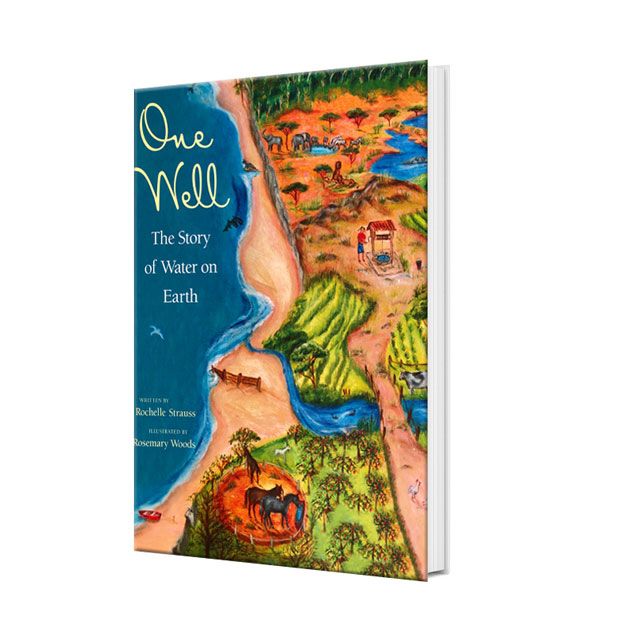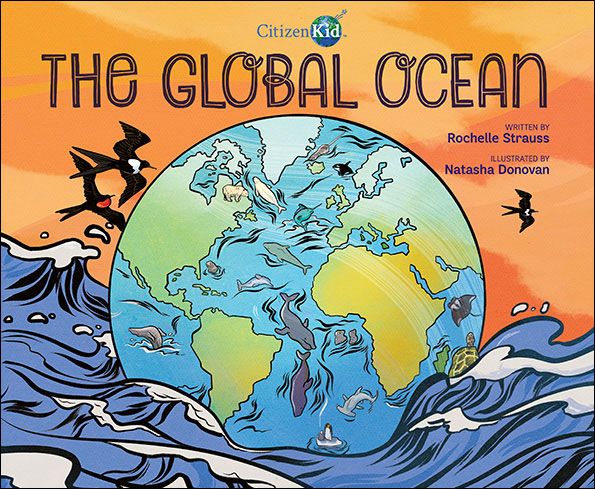In partnership with The Global Goals for #BlueToDo, an initiative raising awareness of the importance of a healthy ocean, Arts Help will publish a series of interviews highlighting artists that combine their creative minds with their passion for the United Nations Sustainable Development Goal of Life Below Water.
Rochelle Strauss is an award-winning children's author based in Toronto. Having a background in environmental studies, experience in education and passion for storytelling, she found her calling in writing children's books about nature. In this interview with Arts Help, Strauss talks about how she got started, what she has learned about the ocean, and how she hopes to inspire young readers.
How did you get started as a writer and what made you decide to write about nature?
Storytelling has always been part of my life and I’ve always loved writing. But the first time I ever wrote a children’s book came in university. It was the final assignment of my children’s literature elective. I wrote a picture book. I loved writing that story—playing with the plot and narrative, finding the humour, enjoying the word play. I was hooked! I continued to dabble, but never had the courage to do anything with what I wrote.
A few years later, I did my master’s in environmental studies, with a focus on environmental education. As part of my final project, I looked at the potential of children’s fiction stories to teach children about nature. I reviewed a ton of kids’ books and experimented with writing one myself. But again, it just sat on my shelf.
I continued to dabble but my writing soon shifted away from books. I began working in the education field, mostly in museums, so my focus was more on content for exhibits. The more I researched and wrote science and nature content though, the more I started to become curious about writing non-fiction books for kids. So, when Kids Can Press invited me to submit a non-fiction book idea, I jumped at the chance! That pitch became my first book—Tree of Life: The Incredible Biodiversity of Life on Earth. And that’s when I started to truly find my voice as a writer.
I love writing about nature because nature itself is filled with so many amazing stories. My books are more narrative in style so my approach combines my love of the natural world and my own curiosity to learn more, with my passion as an educator, and the joy I get playing with words. It’s a great outlet for both my science and my creative sides!

I read that one of your books, One Well: The Story of Water on Earth, is included in the curriculum of various schools across the United States. How does that make you feel?
My goal as a writer is to change the world, one book at a time—so knowing that the books are out there, in the curriculum, teaching and inspiring students is amazing! I especially love when teachers and students share on social media what they are learning, the work they are doing and the actions they are taking as a result of reading One Well. Those posts fill me with so much hope!
Your latest book, The Global Ocean, talks about the biggest issues concerning the health of the ocean. Could you tell us what some of those are?
There are multiple issues affecting the global ocean, but the biggest and most pressing one is climate change.
What people may not realize, is that not only is the planet warming, but the ocean is too. The ocean absorbs about 80-90% of the heat in the atmosphere. So—a warmer Earth means a warmer ocean. Warmer water will impact climate and weather and cause harsher storms. A warmer ocean could also slow ocean currents, which would also change temperatures and weather around the globe. Rising water temperatures will also lead to flooding, destroy ecosystems and threaten marine species.
The global ocean is also a carbon sink—it absorbs and stores CO2 from the atmosphere. More CO2 in the atmosphere will lead to more CO2 in the ocean. This can cause ocean acidification. You may not feel a more acidic ocean when you play in the surf, but ocean acidification threatens countless marine habitats and species.
Other issues affecting the health of the global ocean include pollution—like plastics, abandoned or lost fishing gear, chemical and oil spills, as well as light and sound pollution, the impacts of overfishing—which also includes habitat degradation and bycatch, and of course, habitat loss—such as destroying sea grass meadows or mangrove forests to build along the water’s edge.

The Global Ocean is illustrated by Natasha Donovan. What’s it like to see the illustrations inspired by your words?
Watching the illustrations come to life is one of my favorite parts of the writing process and that was especially true working with Natasha. I am not a visual artist, so I have so much awe and respect for illustrators!!
When I finished writing The Global Ocean and the book got handed over to Natasha, I had no idea what she had in mind or how she might interpret my words. And you may be surprised to hear, I had very little involvement. Beyond me making sure the science was right, the visual narrative was entirely Natasha’s to develop. That’s how it works with children’s books—authors write and then step out of the way to let the illustrators weave their magic.
When the first black and white thumbnails arrived for review, they brought tears to my eyes. It was abundantly clear that Natasha was as passionate about the content as I was. It was obvious that she had done so much research—she included not just interesting and diverse species, but uncommon ones as well. There was one page in particular that immediately caught my eye. She had sketched a ribbon seal in the Arctic page spread. It was so unexpected because ribbon seals are not commonly known, but clearly, she’d done her work! Even in these black and white thumbnails, she’d created vignettes that touched me.
And when the colour proofs came in, the visual narrative just got deeper and richer. I loved her interpretation and especially loved her attention to detail and her inclusion of diversity whenever people were in an image. Representation is very important to me—and clearly just as important for Natasha.
What is one fact that you learned that surprised you during your research for The Global Ocean?
That’s an incredibly hard question to answer because I learned so much doing the research for The Global Ocean. I learned amazing facts about species (I kind of fell in love with cephalopods during the research phase) and was stunned by the severity of some of the issues facing the ocean and awed by all the positive work being done.
But I think, if I look at it holistically, what surprised me the most was the depth to which the ocean influences Earth. Obviously, I knew already that it did, because that was the motivating factor for the book, but as I dove deeper, learning just how intricate and extensively everything is connected and the complex way even the little things are connected, was surprising. For example, I was aware that more CO2 in the ocean could create a more acidic ocean—and more acidic water could eat away at the shells of some species. What I didn’t know was that these species need a mineral (calcium carbonate) in the ocean to build their shells in the first place—but acidic water dissolves that mineral. So a more acidic ocean would mean there’s less calcium carbonate available to even build shells!
Are there any other nature writers you feel inspired by?
I have definitely been influenced by Rachel Carson, Aldo Leopold, Farley Mowat and Barbara Kingsolver—all of whom have taken different paths in their nature writing. But I think I’ve been most inspired by Jacques Cousteau—probably because I grew up surrounded by his books. He introduced me to the most incredible underwater worlds and most amazing species. His adventures and books truly captured my imagination and inspired my love of nature, and especially of the ocean.
Today, I think I am most inspired by the work of Sylvia Earle. But I am also inspired by many children’s authors (both fiction and non-fiction). I learn so much from their content and the creative approaches they take to their work.
Why do you think people, and especially children, should learn and care more about life below water?
First and foremost, because the ocean is the most fundamental feature on the planet. The global ocean is like Earth’s heart. A healthy ocean keeps the planet flourishing and sustains all life on Earth, much like your beating heart keeps you alive.
It’s important for readers to understand that the ocean shapes everything on Earth. It shapes Earth’s climate and influences weather; moves heat, nutrients and oxygen around the planet; it is home to more species and habitats then anywhere else on Earth; it supplies oxygen and stores carbon dioxide; and it’s a source of food for many of Earth’s inhabitants—including us.
By building an understanding of the importance of the global ocean and inspiring their curiosity about life below the water, I hope readers will want to learn more and be empowered to take action to protect the ocean.
You can learn more about Rochelle Strauss on her website, and follow her on Facebook and Instagram.
